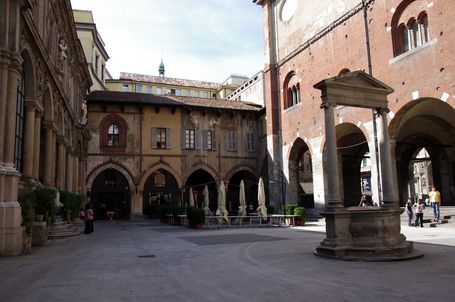

In the glorious days of the Duchy of Milan, Merchants' Square was the busiest corner of town. In the beginning, back in the 13th century, there were six entrances to the square, one for every type of activity.
Today, by the southwestern entrance stands the Casa Panigarola. It is named after a family of notaries that owned the building until the middle of the 18th century. Though built at the height of the Milanese Commune in the 1200's, most of the building was reconstructed in the 1400's in Gothic style. In the portico there is an interesting relief with the emblem of the Sforza family.
To the left of the Casa Panigarola stands the elegant Palazzo delle Scuole Palatine. The current building was built in 17th century after the original Palatine School, built by Gianmaria Visconti in the 1300's, was destroyed in a fire. However, a scholarly institution had stood on this spot ever since the Middle Ages. In fact, St Augustine is widely associated with the institution, as well as 18th century jurist and philosopher Cesare Beccaria. On the façade we see a statue of the saint, as well as that of the Latin poet Ausonius, who had written an epigram in the 4th century about Milan's status as the New Rome.
Adjacent to the Palatine School is the dazzling Loggia degli Osii, decorated with black and white marble. Built in 1321 during the reign of Matteo I Visconti, the building housed the city's judiciary offices. Osii was the family who owned a series of palaces in the neighborhood during the building's construction.
The most important building in Piazza Mercanti, the Palazzo della Ragione, stands on the northern side of the square. The Palazzo della Ragione was built in the middle of the 13th century and ever since has been known as the Broletto Nuovo. Broletto means administrative center, and since there had already been an edifice housing the city's administration, this one became known as the New Broletto. Above the arcs we see a relief of a man on a horse. This is Oldrado da Tresseno, who was podesta, or mayor, of Milan in the beginning of the 13th century.
Before the construction of the Palazzo della Ragione, the square was a bit bigger and stretched out all the way to today's Palazzo dei Giuresconsulti, on Via Mercanti, on the other side of the New Brolleto. Until the end of the 19th century the famous "Oh bej! Oh bej!" fair was held on the square. Though today it is rather silent and somber, the square has perfectly preserved its original architectural and urban character.